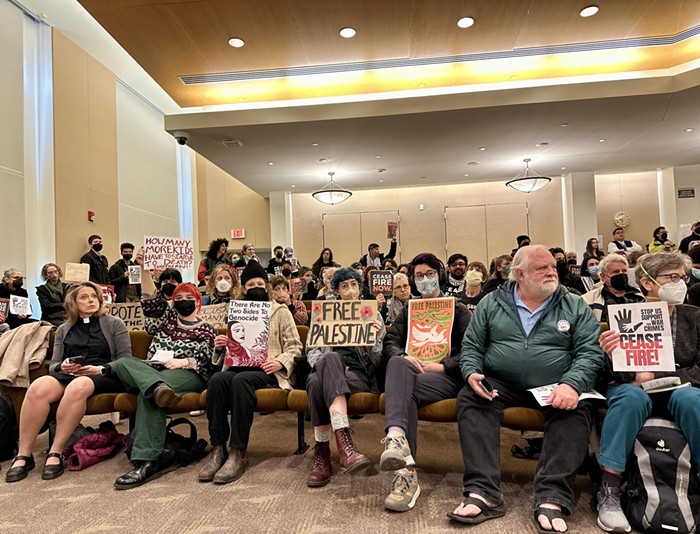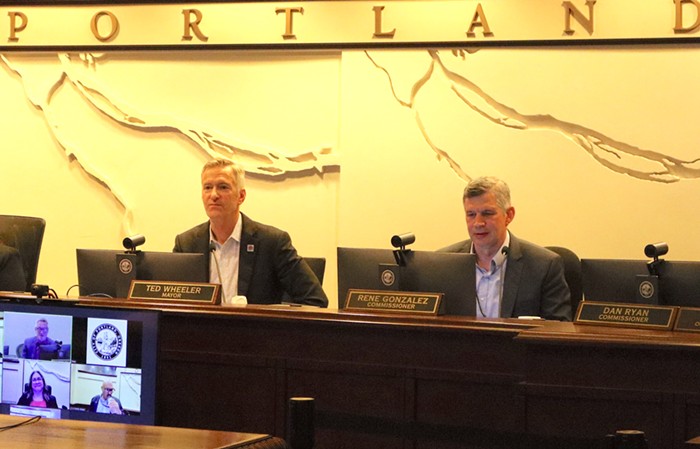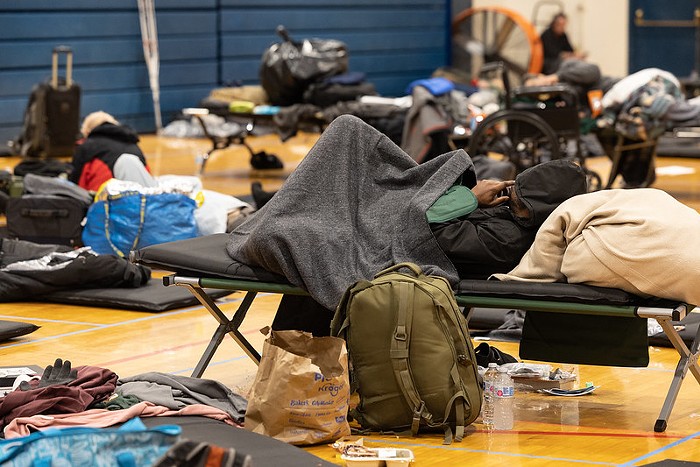EVEN IN a state fairly bursting with cougars, the last couple of months have raised eyebrows.
Oregon's largest wild feline has shown up with notable frequency throughout the Portland region since June—with alarmed and thrilled phone calls coming from Hillsboro, Oregon City, Gresham, Happy Valley, and Portland proper.
One guy in Hillsboro reported being stalked by a cat in the bushes, prompting one of three park closures on account of cougar sightings; a Portland woman found the grisly remains of her housecat; and on Independence Day, what might be a historic first: state wildlife staffers captured a cougar within Portland city limits.
You might have to get used to this sort of thing. Flourishing and fiercely territorial, the state's cougars are increasingly being pushed into areas inhabited by humans, experts say. At the same time, the state employees who assist police departments in dealing with these encounters could become an endangered species.
The Oregon Department of Fish and Wildlife (ODFW) is staring down a deficit of up to $32 million in its next budget. The agency—funded mostly through federal cash and revenue from hunting and fishing permits—has begun reevaluating its responsibilities for offering aid to local authorities in the face of this summer's frequent wildlife reports. For too long, ODFW says, taxpayers in Portland and beyond have gotten assistance for free.
"I've never seen this level of activity as far as urban cougars," ODFW spokesman Rick Swart said recently, after having stepped out of a "cougar debriefing" to take the Mercury's call. Among the questions considered in that meeting, he said: "If the hunters and fishermen are paying my wages and these biologists' wages, is it appropriate for [us] to be handling public safety issues in downtown Portland? Should we really be on call 24 hours a day? Currently, the answer we're finding is: 'Not really.'"
To help make that point, ODFW is preparing to ask Governor John Kitzhaber and the Oregon Legislature for millions more from the state's general fund to shift some of the costs for services, like helping cities handle dangerous animals. The request includes money that would partly fund 53 wildlife staffers, as well as Oregon State Police troopers that deal with wildlife. And it comes as the agency is already getting ready to cut positions.
The biologists and officers are "currently funded with hunter/angler dollars," ODFW's deputy director, Debbie Colbert, told the Oregon Fish and Wildlife Commission at an August 1 hearing, "but they provide broad public benefits and are in line with general tax revenues."
ODFW is the first place local authorities look in a dicey wildlife situation. The agency scrutinizes photos and video to determine whether sightings are legit. It contracts with other agencies for tracking, and it captures, and sometimes kills, animals that have ventured problematically close to urban life.
"We are comfortable handling the initial call to confirm sightings. But if we actually see the animal, we aren't prepared to handle it the same way as ODFW," says Sergeant Pete Simpson, lead spokesman for the Portland Police Bureau. "Cats and dogs are fine—bears and cougars, not so much."
The wildlife agency isn't threatening to fully withdraw its cougar assistance. It's just complaining about being forced to provide assistance for free.
"This is just one example," says spokeswoman Michelle Dennehy. "What we're asking for is not out of line with what we historically have received [from the general fund]."
Sales of hunting and fishing permits, meanwhile, are the lowest in three decades (expect to hear about price increases soon), and the agency's personnel-heavy expenses are projected to rise. ODFW's share of Oregon's $13.7 billion general fund has shrunk steadily over the years, down to roughly five percent of the agency's budget, from upward of 10 percent.
Wildlife officials are hoping to double their allocation, to nearly $40 million, for the state's 2015-2017 budget cycle—though they'll face sharp competition in the horse-trading of state budget politics.
It's against this backdrop that Portland's had what seems like one of its most active years for big predators in recent memory.
In mid-June, a young black bear made its way into Northeast Portland's Concordia neighborhood. The bear was tranquilized near NE 35th and Killingsworth and relocated.
Then on June 23, a Washington County couple hiking in Hillsboro's Jackson Bottom Wetlands Preserve heard a crash in the bushes nearby.
"My wife spotted a cougar in the trees following us," Joe Newman told a 911 dispatcher. "I don't know if you want to call the Game and Fish or what, but someone needs to know, because it's a hiking area. And she says it was hunting us."
Hillsboro closed the preserve, and asked ODFW to investigate. The agency, in turn, called in a tracker from the US Department of Agriculture (USDA). The search turned up nothing, but there was a second sighting—and second closure—at Jackson Bottom the same week.
It was the beginning of a cat-based crucible for the area's 911 dispatchers.
June 29: A cougar crossing SE Division near 121st.
June 30: Another sighting, this time in Gresham.
July 1: A head and paw was all an East Portland woman could find of her housecat.
July 2: Cops saw a cougar in a vegetable field near NE Sandy and 147th before it disappeared into the tree line.
Officials caught up to the animal on Independence Day, in a cedar tree on NE 121st. ODFW biologists showed up, along with the USDA, and their presence sealed the cougar's fate. It's the state's written policy to kill any adult cougar it catches near humans.
"A cougar is not something that the state of Oregon is willing to catch and release," says Swart. There have been a handful of sightings since.
Following the July 4 incident, ODFW administrators asked staffers to tabulate the time they spent dealing with the East Portland cougar. The agency identified more than 100 staff hours, split between removing and killing the animal (27 hours) and dealing with intense media interest (78)—staffing costs the ODFW thinks should be covered by taxpayers.
All the publicity aside, it's hard to say definitively whether cougars are growing more or less problematic. The number of reported incidents fluctuates year to year—sometimes wildly—and is complicated by new reporting standards ODFW instituted in 2007.
In 2005, two years before the new standards, ODFW chronicled 53 reports of cougar activity in Multnomah County—the most in the last decade. A dozen of those reports related to potential public safety threats. In 2007, there were just two complaints in Multnomah County. And in 2013 there were three, including a pair of sightings near Oregon Health and Science University.
Similarly, Clackamas County fielded a striking 102 cougar complaints in 2005, and just seven in 2007, according to agency numbers. There were 10 reports last year, including one account of a cougar that was aggressive toward humans.
The number of cats killed for "public safety" reasons is also up and down. ODFW divides the state into six "zones" for cougar management purposes. Portland is in sprawling Zone A, which includes the Oregon Coast and a huge expanse in the state's northwest corner. Within Zone A, four cougars were killed for safety reasons last year. That compares to 13 in 2012, four in 2011, and 10 in 2010.
Despite those fluctuations, there's no doubt the animals are increasing in number. Dave Williams, state director of the USDA's Wildlife Services wing, says Oregon's cougar population has more than doubled in the last 20 years. It's upward of 6,000, with the bulk in the northeast and southwest sections of the state.
"They get pushed into more marginal areas because there's more people," Williams says. "If they're making a living in and around people, it's just a matter of time before something else happens."
It's Williams' division that tracks and exterminates problem cougars in Oregon. The USDA kills more of the cats than any other public agency in the state.
Like the ODFW, Williams is ambivalent about providing help to Portland when needed—Multnomah County is one of 10 Oregon counties that don't chip in for the USDA's wildlife operations. But also like the ODFW, Williams stops short of saying the USDA won't be there the next time a cougar comes calling. Just don't expect them to hurry.
"Multnomah County doesn't pay for a person on the ground," says Williams. "Our ability to respond at a moment's notice is based on the resources available to us."



















